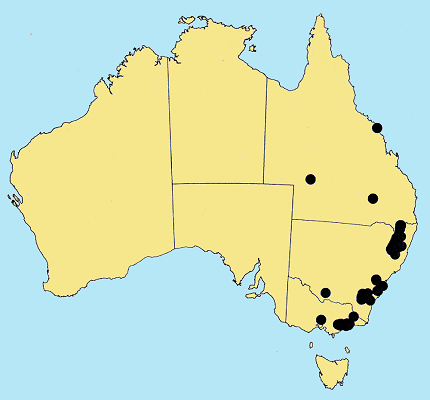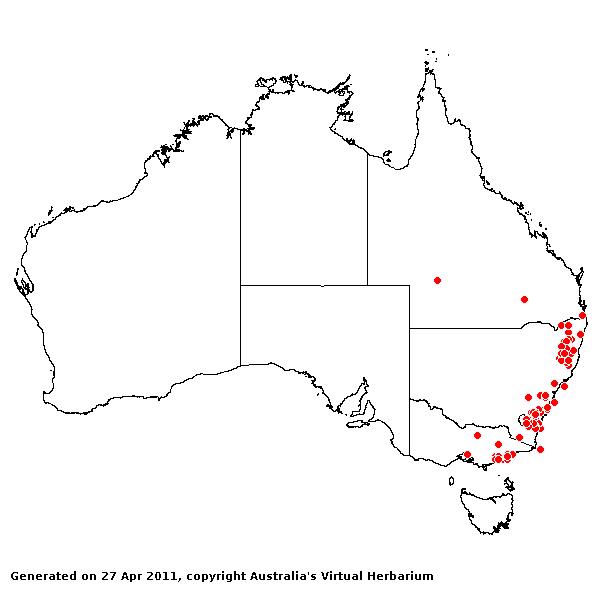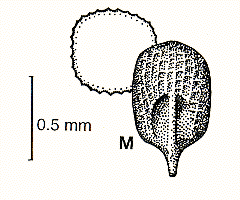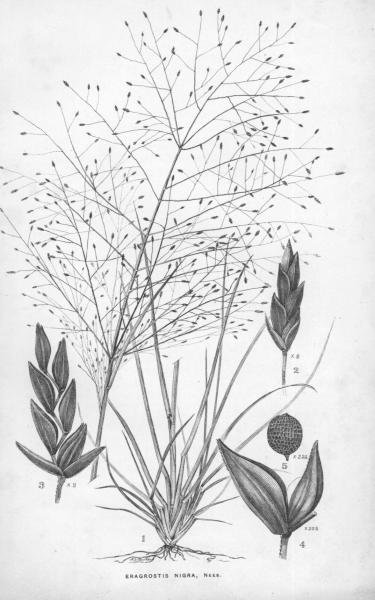Eragrostis trachycarpa (Benth.) Domin. Repert.
Spec. Nov. Regni Veg 9: 552 (1911).
Classification. (GPWG 2001) : Subfamily
Chloridoideae. Cynodonteae.
Basionym and/or
Replacement Name: Eragrostis
nigra var. trachycarpa Benth., Fl. Austral. 7: 643 (1878).
Type of Basionym or
Protologue Information: ST: C. Stuart s.n., Australia: New South Wales:
New England
ST: Perrott s.n.,
Australia: New South Wales: Armidale.
Key references
(books and floras): [1878] G.Bentham, Flora Australiensis 7 (643 as Eragrostis
? nigra), [2002] D.Sharp & B.K.Simon, AusGrass, Grasses of Australia,
[2008] S.W.L.Jacobs, R.D.B.Walley & D.J.B.Wheeler, Grasses of New South
Wales (258).
Illustrations:
[2005] K.Mallet (ed.), Flora of Australia 44B: Poaceae 3
(Fig. 70I-J), [2008] S.W.L.Jacobs, R.D.B.Whalley & D.J.B.Wheeler, Grasses
of New South Wales, 4th edn (258).
Habit.
Perennial. Culms erect, 14–80 cm tall. Leaf-sheaths smooth, glabrous on
surface. Ligule a fringe of hairs, 0.2–0.4 mm long. Leaf-blades straight, flat
or involute or convolute, 1–3 mm wide. Leaf-blade surface smooth or scabrous,
glabrous.
Inflorescence.
Inflorescence compound, a panicle. Panicle ovate, effuse, 15–45 cm long, 8–25
cm wide.
Spikelets.
Spikelets pedicelled. Fertile spikelets 1 or more flowered, with 1 fertile
floret (1–7), comprising 1–7 fertile floret(s), without rachilla extension or
with a barren rachilla extension, lanceolate or oblong, laterally compressed,
1.5–5.5 mm long.
Glumes. Glumes
similar. Lower glume lanceolate, membranous, keeled, 1-keeled, 1 -nerved. Upper
glume lanceolate, 1–2 mm long, membranous, keeled, 1-keeled, 1 -nerved. Upper
glume surface smooth or asperulous.
Florets.
Fertile lemma 1.5–1.7 mm long, keeled, 3 -nerved. Lemma apex muticous. Lodicules
present. Anthers 3. Grain 0.5 mm long.
Continental
Distribution: Australasia.
Australian
Distribution: Queensland, New South Wales, Victoria.
Queensland:
Leichhardt, Darling Downs, Gregory South. New South Wales: Central Coast,
Northern Tablelands, Central Tablelands, Southern Tablelands. Victoria:
Gippsland Plain.
Notes.
Introduced to England by way of land manured with wool shoddy.
Distinguishing characters include panicle
open, decompound, long relative to plant; spikelets loosely flowered, often
olive- green, terminated by a vestigial floret, swollen by the globoid
caryopsis, with wavy rachilla; florets deciduous; lemmas and paleas membranous
to subcoriaceous; lateral nerves on lemma short or obscure; palea 3-toothed,
with mostly smooth keels and wide flaps; caryopsis often globoid, honeycombed,
dark-coloured, stipitate.
Endemic;
distribution is mostly on the coast and tablelands from just N of the
Qld/N.S.W. border S to near Melbourne, Vic.,
also recorded from near Proserpine in northern Qld.; introduced in England. Weed
of roadsides, gardens and disturbed grasslands; on podsolic, brown clayey and
sandy loam soils; often in damp sites and associated with granite.; flowers
Dec.-May, July- Aug., Oct.; fruits Dec.-May, July-Aug., Oct.
